214 Search Results for core boards
April 25, 2013
by Carole Zangari -
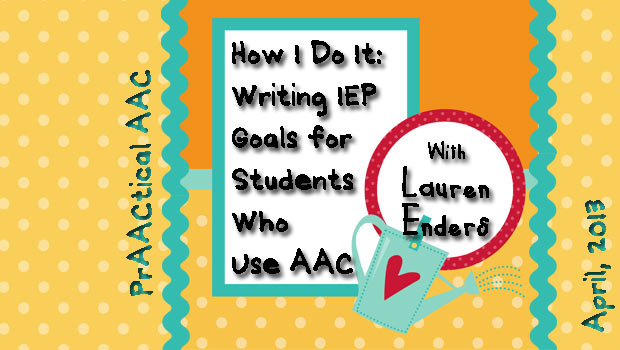
We’re so happy to welcome Lauren Enders back to share some more thoughts on AAC and the IEP. In her first post on this topic, Lauren addressed some frequently asked questions. Today, she provides a very valuable perspective on writing IEP goals for students who use or need AAC and some wonderful resources. Very often, I receive requests for support from teachers and speech therapists that are writing IEP goals for their students who use AAC. When we sit down to discuss their questions, the first thing I remind them is that AAC goals are no different from any other IEP goal. I recall a workshop I attended years ago presented by Gail VanTatenhove that helps put IEP goals for AAC into perspective. Gail said that AAC therapy is just language therapy. Isn’t that true? Aren’t we just teaching language? For this student, language is simply being expressed in a... [Read More...]
April 1, 2013
by Robin Parker -
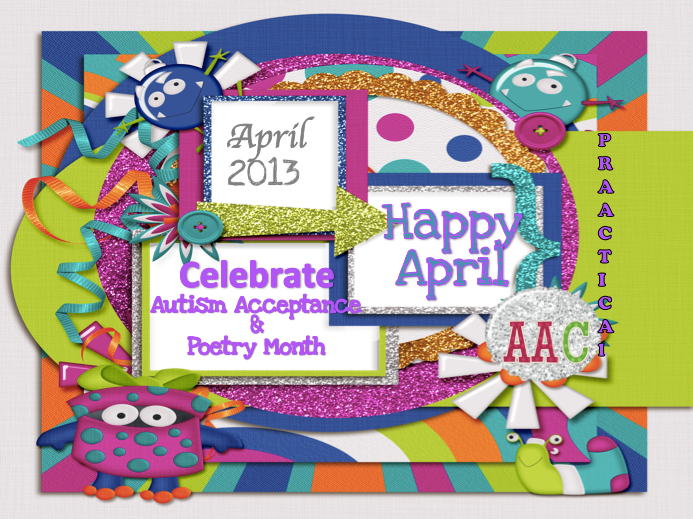
There are a lot of celebrations this month. It is officially Autism Awareness Month. A new name for this that has popped up & taken hold is Autism Acceptance Month. Awareness and/or Acceptance seems to mean different things to different people but hopefully the intent is similar. We hope that this month is filled with great ideas to support ALL people with autism and their families. We hope that educators, clinicians, and whole communities are inclusive, that they presume competence, and that they support communication and language using best prAACtice information and research. We do know that there is more to hope for than just this, like better employment outcomes, more appropriate accommodations, and more individualized support but if focus stays on the former, it seems then that the latter would improve. Plus we have more control (if there is such a thing) on facilitating inclusivity, presuming competence, and of course... [Read More...]
March 26, 2013
by Robin Parker -
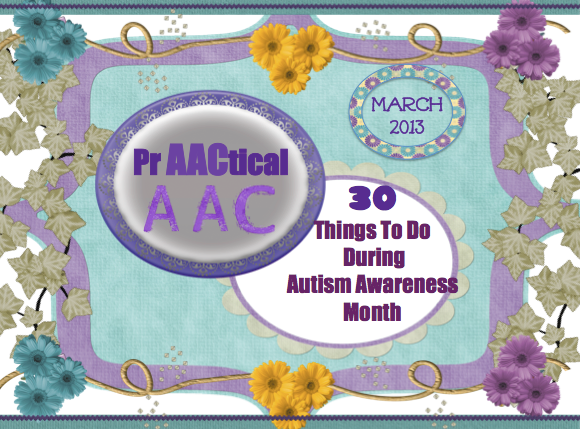
We love getting EVERYONE involved in Autism Awareness/Acceptance Month. We like to take a goal focused approach to our autism activities by choosing projects that facilitate autism awareness & acceptance, positive attitudes, and autism & communication learning. We pass out materials, have contests, go to events, do extra talks, and try and engage EVERYONE we know and even some we do not know. We do a lot of shopping (with small amount of money, but we have to EAT and accessorize). Our families, pets, friends, and students all participate. It is a month filled with purposeful fun. Here are some of the things we will be doing. Please share any activities or projects that you know about. Read & share 5 references that support the use of AAC & Autism (evidence based research) Check out the Online Autistic Carnival which is currently accepting submission of various video documentaries (music, art, writing,... [Read More...]
March 2, 2013
by Carole Zangari -
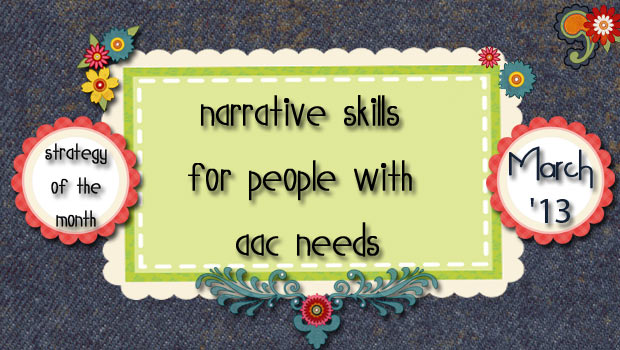
This month, we’ll share some thoughts about helping people with AAC needs develop narrative skills. Why narrative skills? Because they help us connect to one another and communication learning works best when we feel connected. Among other things, storytelling helps us relate to one another. Narrative language is important for reading and writing skills to develop. It helps us understand the world and ourselves. In telling our stories, we establish our identities. Plus, it’s part of what makes life fun. In the US, pediatric therapists are having lots of conversations about the Common Core State Standards (CCSS) in English Language Arts (ELA), and how they relate to the IEP goals of the students that they serve. Many of the goals in the ELA speaking domain require students to be able to summarize what they hear and read, so it is no surprise that SLPs are prioritizing narrative language and related... [Read More...]
January 31, 2013
by Carole Zangari -

We couldn’t be happier that one of our first AACtual Therapists is Tanna Neufeld, a south Floridian on loan to the Pacific Northwest. Tanna was with us as a graduate student many years ago, and went on to build a fantastic reputation in our community for her excellent clinical skills. It was South Florida’s loss when she left last year and moved across the continent. (I know at least a few people scheming of ways to get her back.) Tanna is now working at the Children’s Therapy Center in Seattle. Tanna blogs at SNEAK Outside the Box and My Blind Side. You can read more about her at the end of this post, in which Tanna talks about using bubbles in her AAC therapy sessions. AAC Breakthroughs with Bubbles! When I first started using core vocabulary boards with my kids, I didn’t really know where to start. It was really... [Read More...]
January 26, 2013
by Carole Zangari -
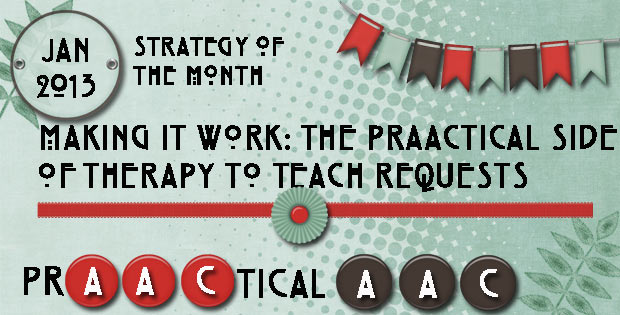
This month we’ve been talking about requesting and choicemaking, specifically how to teach it. Today, we’ll put it into a clinical context by talking about a hypothetical session that targets this skill, but also highlights other strategies. As you read about the materials, preparation, and script, look for how they incorporate strategies such as building specific communication opportunities {CO}, aided language input {ALI}, and expansions {EX}. The clinician also builds in repetition with variety so that there is sufficient opportunities for teaching and practice using multiple modes of communication. In this scenario, you’ll meet Jenna, a 5 year old with significant language difficulties secondary to Cri du Chat syndrome. Jenna’s communication system includes about a dozen manual signs (SIGN), 20-25 word approximations (SPEECH), a few gestures (GEST), some manual communication boards (COMM BD), and an iPad with a full-featured AAC app (iPAD). She also uses movement (MOVEMT), vocalizations (VOC), and... [Read More...]
January 23, 2013
by Carole Zangari -

Want to give your AAC learners more frequent opportunities to interact with others? We love using Language Experience Surveys for this purpose. The concept is a simple one. Once you have a language goal in mind, craft a survey with a key question that the communicator can use as a conversation starter. After some instruction and practice, they can then ask people the question. You’ll need to create visual supports for the survey so that the communicator can use it as a cue and show to the interaction partners. In some surveys, the partners then use the visual support to record their responses. Putting the visual support on a clipboard works well in some situations. The simplest way to do this is with a forced-choice question with a list of response options. The survey could be about favorite TV shows or places to visit, for example, and show different options.... [Read More...]
January 17, 2013
by Carole Zangari -
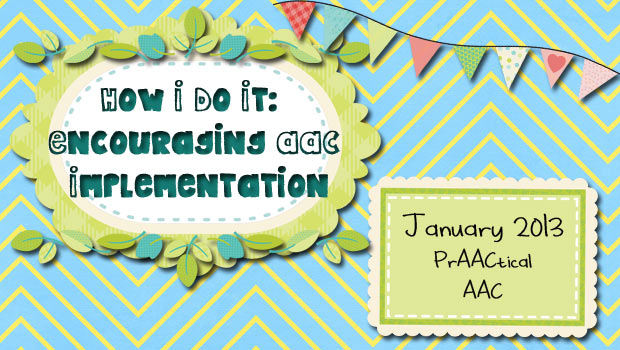
Nothing makes us happier than hearing AAC success stories. It’s thrilling to hear of folks who are using AAC tools and strategies to communicate effectively. We love hearing how their language develops and the positive changes that makes in their lives. It also makes us curious as to what made ‘this’ story a success story. One of our goals for the new year was to give PrAACtical AAC followers a look into the experiences of professionals outside their own communities. Last week, we introduced AACtual Therapy, a series of guest posts by SLPs who are willing to give us a peek into their AAC therapy sessions. Today, we introduce How I Do It, a series in which we invite SLPs to share how they tackle common issues, tasks, or problems. We’re excited to launch the series with a post from Lauren Enders, a clinician who supports the AAC community beyond... [Read More...]
January 15, 2013
by Carole Zangari -
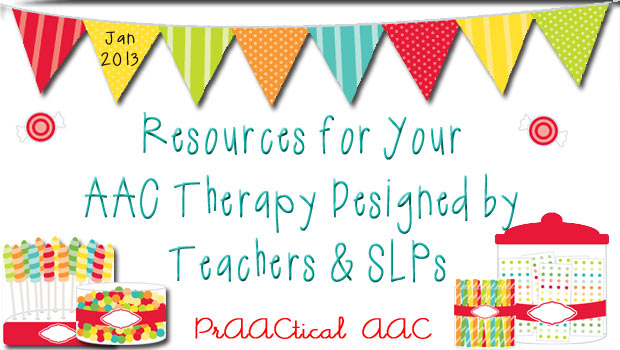
2012 was certainly the year that saw an explosion of SLPs and teachers authoring materials that they offer for sale. TeachersPayTeachers (TpT) is one of several sites that became popular this year and is credited with giving a huge boost to the movement. Here are some of prAACtical interest. Kate Ahern’s Core Word Boards: This set of communication boards can be a big timesaver for anyone who wants to implement a core word approach and needs help in getting set up with some initial materials. (17 pp) Fun for Learning’s visual support with a Star Wars Theme. Use this (or one of her other thematic kits) to customize picture schedules and supports based on the learner’s area of interest. (Free) Working on semantics? This PowerPoint template for making vocabulary teaching supports from Jerilyn can be used to provide practice. (Free) Teaching interrogatives is something that most of us don’t... [Read More...]
January 12, 2013
by Carole Zangari -
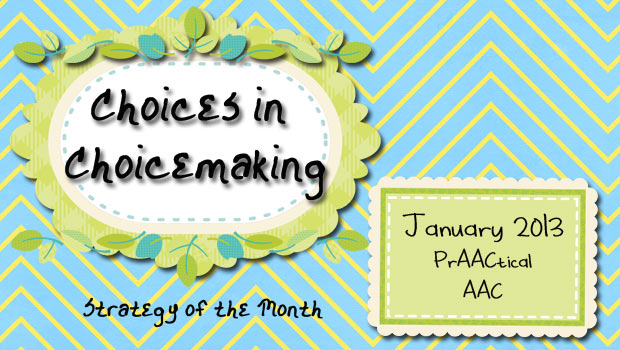
Choicemaking and requesting may be the most frequently targeted areas for beginning communicators who are starting out with their AAC systems. That makes sense for some learners because making choices is a very concrete focus for interaction and is loaded with motivational power. It seems pretty straightforward but, like anything else we do clinically, there are lots of decisions and choices to be made as we delve deeper into the process. How can we craft an AAC system that targets requesting for now, but also supports core language learning? For communicators who are at the earliest stages of making requests with AAC symbols, the strategy we discussed earlier this month or simple choice boards are a good starting point. But unless we quickly address where this is all going, the client will be strictly limited in their language learning. There are many ways to do this. Here is one approach.... [Read More...]









